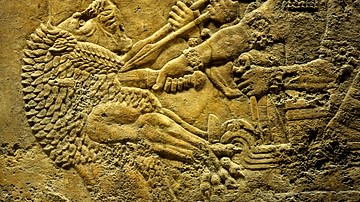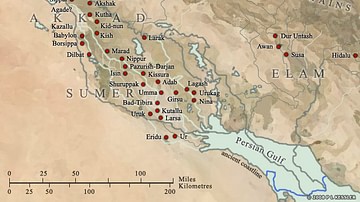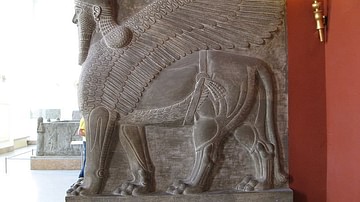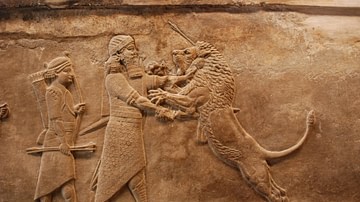Family in ancient Mesopotamia was considered the essential unit that provided social stability in the present, maintained traditions of the past, and ensured the continuance of those traditions, customs, and stability for the future. The family unit was of such importance that the hierarchy of palace and temple was based on it.
The Mesopotamian family unit is described by modern-day scholars as the oikos model from the Greek oikonomia (“management of a household”) from which the English word “economy” is derived (Leick, 65). Scholar Stephen Bertman notes that “the ancient Mesopotamians believed that the family was of central importance to the stability of society” (275). The head of the family was the senior male who was primarily responsible for providing for his family. If the family were upper-class, the head of the household was the male who owned the land; if a lower-class tenant family, he was simply the primary provider.
In extended families, the grandfather was a dependent and the father head of the household. This same paradigm applied to kingship if an elder monarch abdicated in favor of his son (as in the case of Hammurabi of Babylon). In the temple, the god was “head of the household” and the clergy the dependents. Slaves were regarded as dependents and, contingent on the role a slave played in the family, were given greater or lesser liberties.
Marriages were arranged between the father-of-the-bride and the groom or the groom’s father and were rigidly structured. For a marriage to be considered legal, every step of the betrothal process, wedding feast, and move to a new home or building of a new home had to be observed to the letter. Although people could, and did, cohabit without marriage (as in the case of same-sex couples), they and their children (or adopted children) were regarded as outside of the law’s protection or the community’s services.
Families enjoyed their time together just as many do in the present day. People enjoyed sports (wrestling and boxing among males of all classes and hunting among the upper-class), board games (the most popular much like modern Parcheesi), storytelling, dance, and music. Beer was a staple of every family diet and consumed daily by people of all ages at meals of fish, pork, mutton, and vegetable dishes. Families had pets, usually dogs, and the dog collar is thought to have been invented in Mesopotamia, most likely in Sumer.
The importance of the family unit extended into the afterlife as those who had relatives to remember them and make sacrifices were thought to have a happier existence after death than those who died single or without children (especially male children). This same basic model was observed in ancient Egypt, Greece, and Rome but the earliest depictions and inscriptions of family life and its importance in the afterlife come from ancient Mesopotamia around the third millennium BCE. The family, therefore, provided stability through life and past death through devotion to one another.
Family Unit & Marriage
The earliest family groups in Mesopotamian history are recognizable in the same units today. A nuclear family (mother, father, children) often lived with – or near – extended family members (grandparents, aunts, uncles, cousins) and all were part of a larger clan (or tribe). The patriarch of the clan was the oldest living male member, but the head of each household was the male “bread winner” who was responsible for providing for his family, slaves, servants, and members of the extended family who were too old or otherwise unable to provide for themselves. An important responsibility of the head of the household was arranging marriages for his children and this was taken very seriously. Scholar Stephen Bertman comments:
In the language of the Sumerians, the word for “love” was a compound verb that, in its literal sense, meant “to measure the earth”, that is, “to mark off land”. Among both the Sumerians and the Babylonians (and very likely among the Assyrians as well), marriage was fundamentally a business arrangement designed to assure and perpetuate an orderly society. Though there was an inevitable emotional component to marriage, its prime intent in the eyes of the state was not companionship but procreation; not personal happiness in the present but communal continuity for the future. (275-276)
Marriages were contracted to formalize business agreements concerning land sales, water rights, mutual protection, or for any agreement the parties understood as mutually beneficial. As business agreements, they were begun with a legal contract signed by the heads of the households in the presence of witnesses – the bride and groom usually had nothing to do with the proceedings – and, afterwards, the ceremony could move forward. From the first moment a union between families was agreed to, the marriage process had five steps that had to be observed in accordance with tradition to be considered valid:
- Engagement/marriage contract
- Payment of the bride-price to father-of-the-bride and of the dowry to father-of-the-groom
- Ceremony and wedding feast
- Bride moves to her father-in-law’s home
- Sexual intercourse the night of the wedding with the expectation the bride would become pregnant
The bride was also expected to be a virgin without any legal constraints that might nullify the marriage agreement (such as already being engaged to another) but the bride (or groom) had no say in the marriage going forward once the contract was signed and payments made between families. The ceremony was often as simple as the bride moving to the groom’s family home where a feast was held and there was little tolerance for interference in this progress once the contract was signed. Bertman notes:
Engagements were serious business in Babylonia, especially for those who might have a change of heart. According to Hammurabi’s Code, a suitor who changed his mind would forfeit his entire deposit (betrothal gift) and bride-price. If the prospective father-in-law changed his mind, he had to pay the disappointed suitor double the bride-price. Furthermore, if a rival suitor persuaded the father-in-law to change his mind, not only did the father-in-law have to pay double, but the rival wasn’t allowed to marry the daughter. These legal penalties acted as a potent deterrent against changes of heart and a powerful incentive for both responsible decision making and orderly social behavior. (276)
The new couple usually lived with the groom’s parents at first until they could afford to move to their own home. Some couples remained in the home of the groom as the wife took on the responsibility of caring for members of the extended family.
Home, Palace & Temple
For those who could afford it, however, or were forced to move to a new home due to overcrowding, the process was as regulated as that of the marriage. A plot of land was purchased through negotiation and a legal agreement signed by cylinder seals and, before any construction could begin, the brother-gods Kabta and Mushdamma were invoked for their blessings. Kabta and Mushdamma were the gods who presided over construction, bricks, buildings, and foundations and if one forgot – or ignored – them, one invited bad luck which might even result in the house collapsing. Once the home was completed, the god Arazu (the deity of completed construction) required offerings of thanksgiving for what had been accomplished and the future security and safety of the home.
Most homes were built of woven reeds and marsh plants with reed mats for a roof or of sun-dried brick and reed mats. Oven-baked brick was more durable but expensive and usually used for palaces, temples, and the homes of nobility and the upper-class. Most homes did not have windows but those that did featured wooden grill work with reeds as “window glass”. Wood was rare in Mesopotamia, however, and costly and so only upper-class homes had windows. Lower-class homes were lighted by sesame seed oil lamps and holes in the roof above the hearth. There was always only one door, and it was painted red to ward off evil spirits. Since spirits were thought to enter a home through doors and windows, more than one door was considered a serious risk of spiritual attack either by demons, malevolent spirits, or ghosts of departed family members.
Once the family had moved into their new home, the male assumed the role of head of the household and a new branch of the family was established there. As noted, the family was considered the foundation of the whole of society and so the hierarchy of both palace and temple mirrored it. In the palace, the king was “head of the household” who was responsible for the well-being of those who lived there (his family, extended family, administrators, staff, and slaves) but, in his role as monarch, was head of his kingdom and all its citizens were understood as his children. This paradigm is seen as far back as Sargon of Akkad (Sargon the Great, r. 2334-2279 BCE) but is probably best known from the reign of Ur-Nammu (2047-2030 BCE) who, modeling his reign on Sargon’s, went further in depicting himself as a father-figure whose first responsibility was toward his subjects.
The head of the household in the temple was the deity who was thought to live there. The temple was understood as home of the god or goddess it had been built to honor and that deity owned the land, the structure, and whatever resources the temple generated. The high priest or priestess administered and supervised in accordance with the deity’s wishes, but they were understood to be serving as stewards, not as the primary authority. These stewards would act in accordance with the will of the god or goddess in the same way counselors and bureaucrats would with the king or the members of a household would with the father-figure.
Sex, Work & Leisure
Couples were expected to be monogamous as their relationship mirrored that of the king who was symbolically “married” to a deity to ensure the fertility and prosperity of the land. There were exceptions, however, as scholar Jean Bottero notes:
Once settled in her new status, all the jurisprudence shows us the wife entirely under the authority of her husband, and social constraints – giving the husband free rein – were not kind to her. In the first place, although monogamy was common, every man – according to his whims, needs, and resources – could add one or more “second wives”, or rather, concubines, to the first wife. (115)
Women had nearly equal rights throughout most of the history of ancient Mesopotamia but if a woman deserted her husband and took a lover, she was severely punished while the same did not apply to a man. If a woman were caught in the act of adultery, she would be bound to her lover and thrown into the river or otherwise executed. A woman could divorce a man if she found he were gay and had no interest in sleeping with her. As procreation was the goal of marriage, a man who refused to sleep with his wife was thought to have broken the marriage contract.
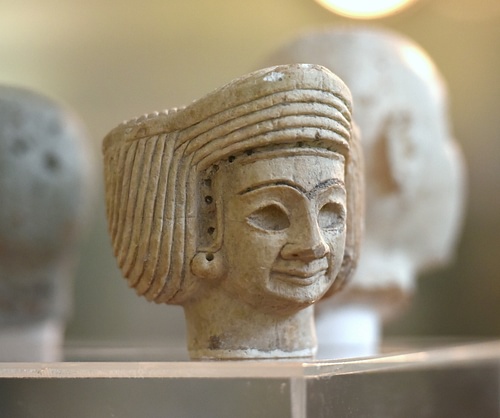
At the same time, however, there were no prohibitions against gay sex and, as Bottero notes, “Homosexual love could be enjoyed” without stigma (101). The goddess Inanna (later Ishtar) was famous for turning men into women and women into men and her clergy were bisexual or transgender in keeping with Inanna’s association with transformation. The only stigma attached to gay sex was engaging in a same-sex relationship with someone of a higher or lower class than oneself but this same applied to opposite-sex couples. Intimacy between classes posed a problem because it violated the rules of social hierarchy but there is nothing in the records condemning gay couples or gay sex except in the case of a man of a higher class “playing the part of a woman” with one of a lower class. Otherwise, as Bottero writes:
Making love was a natural activity, as culturally ennobled as food was elevated by cuisine. Why on earth should one feel demeaned or diminished or guilty in the eyes of the gods, practicing it in whatever way one pleased, always provided that no third party was harmed or that one was not infringing any of the customary prohibitions which controlled daily life. (97)
If a man chose to leave his wife, he had to provide for her (except in cases of adultery or abandonment) by returning her property (dowry) and, as noted, could have as many sexual partners as he could afford but if a woman even expressed the thought of leaving her husband, unless there were legal grounds, she could be forced from the family home to live on the streets, often with no choice but to make a living as a prostitute. At the same time, a woman could initiate divorce proceedings if she had legal grounds, own her own land, enter into business contracts, buy and sell slaves, and operate businesses. The first brewers in Mesopotamia were women and there are records of women owning taverns, farms, and other enterprises.
Men and women, and even children over the age of four or five, usually worked from just after daybreak until dusk, depending on the occupation. Lower-class jobs included artists, bakers, basket makers, brewers, butchers, carpenters, construction workers, cup bearers, farmers, fishermen, musicians, perfume makers, prostitutes, and soldiers. Upper-class jobs included scribes, tutors, teachers, merchants, architects, priests, astrologers, and bureaucrats as well as officers in the military and palace administrators.
Leisure activities revolved around the family and community and included storytelling – which might take the form of a dramatic performance – as well as board games, sports, hunting (for the upper class), musical performances, and competitions. Children played with toys, balls, and other items similar to children’s toys in the present such as baby dolls and small bows and arrows or miniature ships, animal figures, or carts. Festivals also provided an opportunity for leisure activities while also honoring the gods and thanking them for their gifts. Families would attend these festivals together and one’s children were expected to not only continue that tradition but provide for one in the afterlife.
Conclusion
When one died, the corpse was washed, anointed, and clothed at home by family members. The body was then interred in a tomb (for the upper class) or buried in or near the family home. The favorite possessions of the deceased would be buried with them along with any other items a family could afford to part with that might prove useful in the afterlife. Unlike ancient Egypt, with its vision of the paradise of the Field of Reeds, or other civilizations, the afterlife of the Mesopotamians was a bleak world of darkness where every soul, no matter how noble or mean one’s life, met with the same fate in the realm presided over by the dark goddess Ereshkigal. Bertman cites the scholar Georges Contenau on this:
In this region, illumined by no ray of light, wholly shrouded in dust, airless, and lacking food and drink, the only sustenance of the spirits of the dead was the funerary offerings. If no man remembered them, then they returned to plague the living, subsisting as best they might on such miserable scraps of food as they could find in the gutters. (281)
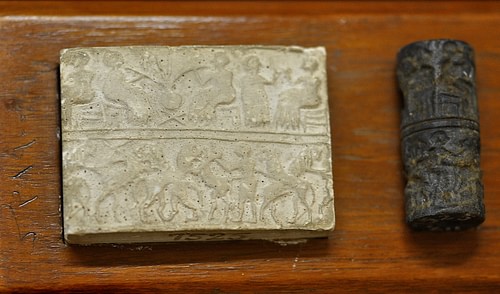
Unless one died suddenly, the family would gather around the person’s death bed, sometimes with a clergy member present, and offer prayers to the gods for an easy passage. These prayers might be offered to Gula, the Babylonian goddess of healing, or to her son, Ninazu, associated with transformation and the transition to the afterlife. A doctor – either the Asu (medical doctor) or Asipu (spiritual healer) – might also be present. A chair would be set near the deathbed for the spirit to rest on after it left the body and, as Bertman notes, “the first spiritual offerings, beer and flat bread to strengthen the soul for its long journey to the underworld” would be set beside it (281). After the soul had left the body, the washing and anointing would take place.
Once the soul passed to the afterlife, however, it was dependent on the gifts of remembrance of the living. As Contenau notes above, souls that were not remembered, and who did not receive food and drink offerings, would try to return to the world of the living to demand them and, if that failed, would do their best to survive on scraps, disrupting the natural order and introducing chaos to the community.
Ereshkigal was said to have seven gates set between the realm of the dead and the living to prevent such problems as hauntings but, even so, it was thought a spirit might somehow slip through and return to the family, bringing misfortune. Families were therefore encouraged to carefully observe all the proper rituals of burial and remember the departed afterward through offerings in their honor. In this way, family served as the essential unit for stability in life, and also after death, as the members continued to care for and honor the deceased, continuing the tradition for the next generation.



